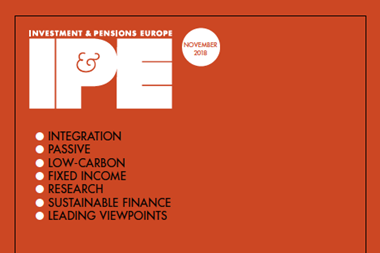Company executives should receive pension contributions in line with the majority of their workforce, the UK’s asset management trade body has said.
The Investment Association’s (IA) 2018 Principles of Remuneration, published today, included an expectation that companies pay contributions to directors’ pension pots in line with the rate given to the majority of the rest of the workforce – as opposed to making higher contributions as a mechanism for increasing total pay.
This in line with a provision in the UK’s corporate governance code.
Companies should also require executive directors to hold a proportion of their shares for at least two years after they leave a company “so that they consider the long-term value of the company even after their departure”, the IA said.
The demands were part of the trade body’s “clearer and sharper” expectations about executive pay, made in response to growing frustration that many companies were not listening to investors’ views on the subject.
In a letter to the chairs of FTSE 350 companies’ remuneration committees, the IA said the review of its executive pay guidelines had taken into account the new UK corporate governance code as well as increasing dissent on remuneration resolutions in the FTSE 100 this year.
“The political and media focus on executive remuneration continues to grow with the forthcoming implementation of new remuneration reporting requirements and an ongoing [parliamentary] inquiry into fair pay,” it added.
Andrew Ninian, director of stewardship and corporate governance at the IA, said “a stubborn minority” of the UK’s largest companies were still not responding to shareholder concerns about pay.
“Our strengthened guidelines make clear that companies need to demonstrate more robustly the link between pay and company performance,” he said. “If they don’t, they should brace themselves for more shareholder revolts in 2019.”
The IA’s new principles also conveyed an update on investors’ expectations with regard to restricted share plans. Shareholders are split on these, but the IA said a majority of its members were willing to consider them although their support “is clearly dependent on the strategic rationale for restricted shares at that company as well as other conditions being in place”.
Key messages on climate scenario analysis
Climate-savvy investors have developed a climate scenario analysis guide to help less experienced peers come to grips with what they say is a vital risk management tool.
Published by the International Investors Group on Climate Change (IIGCC) today, the guide is aimed at helping asset owners and asset managers “close the knowledge gap” on scenario analysis, one of the key recommendations made by the Task Force on Climate-related Financial Disclosures.
There was “added urgency” to making climate change a standard part of investors’ risk management processes as the physical impacts of climate change were increasingly clear, according to the IIGCC.
The guide was developed with input from Swedish pension buffer fund AP2, and asset managers APG, BMO, HSBC, and UBS, and others.
In a LinkedIn post, Vicki Bakhshi, director of governance and sustainable investment at BMO Global Asset Management, said she was proud to have been involved in producing the report.
“We hope it helps clarify the options for investors who want to use climate scenario analysis, but may be unsure how to progress,” she said.
The guide, she said, encouraged investors to “be clear about your objectives, as there’s no one-size-fits-all methodology”.
Stephanie Pfeifer, CEO of the IIGCC, added: “Perhaps the most important conclusion of the guide we’ve published is that the journey is often the destination.
“Many benefits of scenario analysis for investors come through undertaking the process, experimenting with methodologies and learning about the ways in which climate change drives financial impacts.”
The guide can be found here.












No comments yet